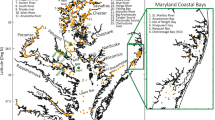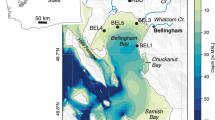Abstract
The Salton Sea is the largest lake, on a surface area basis, in California (939 km2). Although saline (>44 g/l) and shallow (mean depth approximately 9.7 m), it provides valuable habitat for a number of endangered species. The distribution of sediments and their properties within the Salton Sea are thought to have significant influence on benthic ecology and water quality. Sediment properties and their distribution were quantified and compared with predicted distributions using several sediment distribution models. Sediment samples (n = 90) were collected using a regular staggered-start sampling grid and analyzed for water content, organic carbon (C), calcium carbonate, total nitrogen (N), total phosphorus (P), organic phosphorus, and other properties. Water content, total N, and total and organic P concentrations were all highly correlated with organic C content. The organic C concentration showed a non-linear increase with depth, with low organic C contents (typically 1–2%) present in sediments found in depths up to 9 m, followed by a strong increase in organic C at greater depths (to about 12% at 15 m depth). The models of Hakanson, Rowan et al., Blais and Kalff, and Carper and Bachmann yielded very different predicted critical depths for accumulation (10.5–22.8 m) and areas of accumulation (0–49.5%). Hakanson’s dynamic ratio model more reasonably reproduced the observed zone of elevated organic C concentrations in the Salton Sea than either exposure- or slope-based equations. Wave theory calculations suggest that strong winds occurring less than 1% of the time are sufficient to minimize accumulation of organic matter in sediments that lie at depths less than 9 m in this system.







Similar content being viewed by others
References
APHA, 1998. Standard Methods for the Examination of Water and Wastewater (20th Ed.). American Public Health Association, Washington, DC.
Arnal, R. E., 1961. Limnology, sedimentation, and microorganisms of the Salton Sea, California. Geological Society of America Bulletin 72: 427–478
Aspila, K. I., H. Agemian & A. S. Y. Chau, 1976. A semi-automated method for determination of inorganic, organic and total phosphate in sediments. Analyst 101: 187–197.
Berner, R. A. & J. L. Rao, 1994. Phosphorus in sediments of the Amazon River and estuary: implications for the global flux of phosphorus to the sea. Geochimica Cosmochimica Acta 58: 2333–2339.
Blais, J. M. & J. Kalff, 1995. The influence of lake morphometry on sediment focusing. Limnology and Oceanography 40: 582–588.
Bloesch, J., 1995. Mechanisms, measurement and importance of sediment resuspension in lakes. Marine and Freshwater Research 46: 295–304.
California Irrigation Management Information System (CIMIS). 2004. California Dept. of Water Resources. www.cimis.water.gov.
Carper, G. L. & R. W. Bachmann, 1984. Wind resuspension of sediments in a prairie lake. Canadian Journal of Fisheries and Aquatic Sciences 41: 1763–1767.
Cook, C. B., G. T. Orlob & D. W. Huston, 2002. Simulation of wind-driven circulation in the Salton Sea: implications for indigenous ecosystems. Hydrobiologia 473:59–75.
Cyr, H., 1998. Effects of wave disturbance and substrate slope on sediment characteristics in the littoral zone of small lakes. Canadian Journal of Fisheries and Aquatic Sciences 55: 967–976.
Danen-Louwerse, J. H., L. Lijklema & M. Coenraats, 1995. Coprecipitation of phosphate with calcium carbonate in Lake Veluwe. Water Research 29: 1781–1785.
Detwiler, P. M., M. F. Coe & D. M. Dexter, 2002. The benthic invertebrates of the Salton Sea: distribution and seasonal dynamics. Hydrobiologia 473: 139–160.
Duarte, C. M. & J. Kalff, 1986. Littoral slope as a predictor of the maximum biomass of submerged macrophyte communities. Limnology and Oceanography 31: 1072–1080.
Ferrari, R. L. & P. Weghorst, 1997. Salton Sea 1995 Hydrographic GPS Survey. Bureau of Reclamation, Water Resources Services, Technical Service Center, Denver, CO.
Förstner, U & G. T. W. Wittmann, 1979. Metal Pollution in the Aquatic Environment. Springer-Verlag, Berlin.
Freeman, J. S. & D. L. Rowell, 1981. The adsorption and precipitation of phosphate onto calcite. Journal of Soil Science 32: 75–84.
Gee, G. W. & J. W. Bauder, 1986. Particle-size analysis. In Klute A. (ed.), Methods of Soil Analysis. Part 1. 2nd Ed. Agronomy Monographs 9. ASA and SSSA, Madison, WI: 383–411.
Gilbert, R., 1999. Calculated wave base in relation to the observed patterns of sediment distribution in northeastern Lake Ontario. Journal of Great Lakes Research 25: 883–891.
Hakanson, L., 1977. The influence of wind, fetch, and water depth on the distribution of sediments in Lake Vanern, Sweden. Canadian Journal of Earth Sciences 14: 397–412.
Hakanson, L., 1981. On lake bottom dynamics – the energy-topography factor. Canadian Journal of Earth Sciences 18: 899–909.
Hakanson, L., 1982. Lake bottom dynamics and morphometry: the dynamic ratio. Water Resources Research 18: 1444–1450.
Hakanson, L. & M. Jansson, 1983. Principles of Lake Sedimentology. Springer-Verlag, New York, NY.
Hargrave, B. T., 1972. Aerobic decomposition of sediment and detritus as a function of particle surface area and organic content. Limnology and Oceanography 17: 583–596.
Hatcher, K. J. 1986. Sediment Oxygen Demand: Processes, Modeling & Measurement. Institute of Natural Resources, Univ. of Georgia, Athens, GA.
Holdren, G. C. & D. E. Armstrong, 1980. Factors affecting phosphorus release from intact lake sediment cores. Environmental Science and Technology. 14: 79–87.
Holdren, G. C. & A. Montaño, 2002. Chemical and physical characteristics of the Salton Sea, California. Hydrobiologia 473: 1–21.
Huston, D. W., 2000. Application of a Wind Field Analysis to a Three-Dimensional Hydrodynamic Model of the Salton Sea, California. M.S. Thesis, Univ. of California, Davis.
Jones, J. G., 1980. Some differences in the microbiology of profundal and littoral zone sediments. Journal of General Microbiology 117: 285–292.
Karickhoff, S. W., D. S. Brown & T. A. Scott, 1979. Sorption of hydrophobic pollutants on natural sediments. Water Research 13: 241–248.
King, I. P. 1993. A finite element model for three-dimensional density stratified flow. Australian Water and Coastal Studies Report, April.
Lehman, J. T., 1975. Reconstructing the rate of accumulation of lake sediment: the effect of sediment focusing. Quaternary Research 5: 541–550.
Lenhard, G., W. R. Ross & A. duPlooy, 1962. A study of methods for the classification of bottom deposits of natural waters. Hydrobiologia 20: 223–240.
Loeppert, R. H. & D. L. Suarez, 1996. Carbonate and gypsum. In Sparks, D. L. (ed.), Methods of Soil Analysis. Part 3. 3rd Ed. Agronomy Monographs 9. ASA and SSSA. Madison, WI: 437–474.
Martin, J. L. & S. C. McCutcheon, 1999. Hydrodynamics and Transport for Water Quality Modeling. Lewis Publ., Boca Raton, FL.
Nagid, E. J., D. E. Canfield & M. V. Hoyer, 2001. Wind-induced increases in trophic state characteristics of a large (27 km2), shallow (1.5 m mean depth) Florida lake. Hydrobiologia 455: 97–110.
Nelson, D. W. & L. E. Sommers, 1982. Total carbon, organic carbon, and organic matter. In: Page, A. L., R. H. Miller & D. R. Keeney (eds), Methods of Soil Analysis, Part 2. 2nd ed. Agronomy Monographs 9. ASA and SSSA., Madison, WI: 539–580.
Peeters, E. T. H. M., R. Gylstra & J. H. Vos, 2004. Benthic macroinvertebrate community structure in relation to food and environmental variables. Hydrobiologia 519: 103–115.
Reddy, K.R., M. M. Fisher & D. Ivanoff, 1996. Resuspension and diffusive flux of nitrogen and phosphorus in a hypereutrophic lake. Journal of Environmental Quality 25: 363–371.
Rowan, D. J., J. Kalff & J. B. Rasmussen, 1992a. Estimating the mud deposition boundary depth in lakes from wave theory. Canadian Journal of Fisheries and Aquatic Sciences 49: 2490–2497.
Rowan, D. J., J. Kalff & J. B. Rasmussen, 1992b. Profundal sediment organic content and physical character do not reflect lake trophic status, but rather reflect inorganic sedimentation and exposure. Canadian Journal of Fisheries and Aquatic Sciences 49: 1431–1438.
Rowan, D. J., J. B. Rasmussen & J. Kalff, 1995. Optimal allocation of sampling effort in lake sediment studies. Canadian Journal of Fisheries and Aquatic Sciences 52: 2146–2158.
Salton Sea Authority/USBR, 2000. Draft Salton Sea Restoration Project Environmental Impact Statement/Environmental Impact Report. Report prepared for the Salton Sea Authority and U.S. Department of the Interior, Bureau of Reclamation, by Tetra Tech, Inc.
Schroeder, R. A., W. H. Orem & Y. K. Kharaka, 2002. Chemical evolution of the Salton Sea, California: nutrient and selenium dynamics. Hydrobiologia 473: 23–45.
Sondegaard, M., J. P. Jensen & E. Jeppesen, 2003. Role of sediment and internal loading in shallow lakes. Hydrobiologia 506–509: 135–145.
Sykes, G., 1937. The Colorado delta. American Geographic Society Special Publicaion 19, pp. 132–133.
USBR. 2000. Salton Sea Restoration Project, Draft Alternatives Appraisal Report. Bureau of Reclamation, Lower Colorado Region, Boulder City, NV, 67 pp.
USGS. 2006. National Water Information System. Water surface elevation data for the Salton Sea. USGS station #10254005, Salton Sea near Westmorland, CA. http://www.waterdata.usgs.gov.
Vogl, R. A. & R. N. Henry, 2002. Characteristics and contaminants of the Salton Sea sediments. Hydrobiologia 473: 47–54.
Watts, J. M., B. K. Swan, M. A. Tiffany & S. H. Hurlbert, 2001. Thermal, mixing, and oxygen regimes of the Salton Sea, California, 1997–1999. Hydrobiologia 466: 159–176.
Yuan, F., B. K. Linsley & S. S. Howe, 2006. Evaluating sedimentary geochemical lake-level tracers in Walker Lake, Nevada, over the last 200 years. Journal of Paleolimnology 36: 37–54.
Acknowledgments
This research was sponsored by Salton Sea Authority, La Quinta, California. Special thanks to Ed Betty for his assistance in the field sampling.
Author information
Authors and Affiliations
Corresponding author
Additional information
Guest editor: S. H. Hurlbert
The Salton Sea Centennial Symposium. Proceedings of a Symposium Celebrating a Century of Symbiosis Among Agriculture, Wildlife and People, 1905–2005, held in San Diego, California, USA, March 2005
Rights and permissions
About this article
Cite this article
Anderson, M.A., Whiteaker, L., Wakefield, E. et al. Properties and distribution of sediment in the Salton Sea, California: an assessment of predictive models. Hydrobiologia 604, 97–110 (2008). https://doi.org/10.1007/s10750-008-9308-1
Published:
Issue Date:
DOI: https://doi.org/10.1007/s10750-008-9308-1




